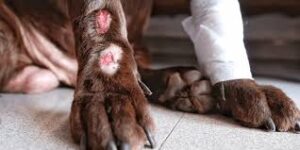Acral lick dermatitis is a chronic skin condition resulting from excessive licking of a particular area, often leading to a thickened, ulcerated, and infected lesion. The most commonly affected areas are the front legs, although other parts of the body can also be involved.

Acral lick dermatitis, commonly known as lick granuloma, is a frustrating and persistent condition that affects many dogs. Characterized by excessive licking of a specific area, usually on the legs, this condition can lead to significant skin damage and infection. This comprehensive guide explores the causes, clinical signs, treatments, and preventive measures for acral lick dermatitis in dogs, along with answers to frequently asked questions.
Causes of Acral Lick Dermatitis:
Acral lick dermatitis can be caused by various factors, including:
- Psychological Factors: Boredom, stress, anxiety, and compulsive behaviors are common psychological triggers.
- Allergies: Environmental, food, or flea allergies can cause itching, leading to excessive licking.
- Infections: Bacterial or fungal infections can irritate the skin, prompting the dog to lick the area.
- Pain: Underlying pain from arthritis, bone fractures, or nerve damage can lead to licking as a coping mechanism.

Clinical Signs of Acral Lick Dermatitis:
Early Signs:
- Frequent licking of a specific area
- Redness and swelling of the affected site
- Hair loss around the licked area
Advanced Signs:
- Thickened and ulcerated skin
- Open, oozing sores
- Secondary bacterial infections
- Scarring and pigmentation changes
- To know about Moist Dermatitis in Dogs [CLICK HERE]
Diagnosis and Treatment of Acral Lick Dermatitis:
Diagnosis:
- Physical Examination: A veterinarian will examine the affected area and assess the extent of the lesion.
- Skin Scraping and Cytology: To identify any underlying bacterial or fungal infections.
- Allergy Testing: To determine if allergies are contributing to the condition.
- Radiographs or Ultrasound: To rule out underlying pain or structural abnormalities.
Treatment:
Medical Treatment:
- Topical Medications: Antibiotic and anti-inflammatory creams or ointments to reduce infection and inflammation.
- Oral Medications: Antibiotics, anti-inflammatory drugs, or medications to address underlying allergies.
- Behavioral Therapy: Anti-anxiety medications or supplements to address psychological triggers.
Environmental and Behavioral Management:
- Physical Barriers: Use of e-collars or bandages to prevent licking.
- Environmental Enrichment: Providing toys, puzzles, and regular exercise to reduce boredom and anxiety.
- Behavior Modification: Training and techniques to redirect the dog’s attention away from licking.
Prevention Strategies:
Regular Grooming and Skin Care:
Frequent grooming helps maintain healthy skin and coat, reducing the risk of irritation and infection.
Allergy Management
Identifying and managing allergies can significantly reduce the incidence of acral lick dermatitis. Consult your veterinarian for appropriate allergy testing and treatment.
Environmental Enrichment
Providing a stimulating environment with plenty of physical and mental activities can help prevent boredom and anxiety-related licking behaviors.
Proper Nutrition
A balanced diet rich in essential nutrients supports the overall health of your dog, including skin health, making them less susceptible to skin conditions.
Conclusion:
Acral lick dermatitis is a challenging condition that requires a multifaceted approach for effective management. By understanding the causes, recognizing the clinical signs, and implementing appropriate treatment and preventive strategies, pet owners can help their dogs achieve relief and improve their quality of life. Always consult with a veterinarian for proper diagnosis and treatment to ensure the best outcome for your furry companion.
- For more information about [CLICK HERE]
FAQs :
Q1: Can acral lick dermatitis be cured completely?
A1: While acral lick dermatitis can be managed and treated effectively, it is often a chronic condition that may require ongoing management to prevent recurrence.
Q2: Is acral lick dermatitis contagious to other pets or humans?
A2: No, acral lick dermatitis is not contagious. It is a condition caused by the dog’s own behavior and underlying health issues.
Q3: How long does it take for a lick granuloma to heal?
A3: Healing time varies depending on the severity of the lesion and the effectiveness of the treatment. With proper management, improvement can be seen within a few weeks, but complete healing may take several months.
Q4: Can I treat acral lick dermatitis at home?
A4: While some home remedies can provide temporary relief, it’s crucial to consult with a veterinarian for proper diagnosis and comprehensive treatment to address the underlying causes.
Q5: Are certain breeds more prone to acral lick dermatitis?
A5: Yes, certain breeds such as German Shepherds, Labrador Retrievers, Golden Retrievers, and Doberman Pinschers are more prone to developing acral lick dermatitis due to their predisposition to allergies and compulsive behaviors.

